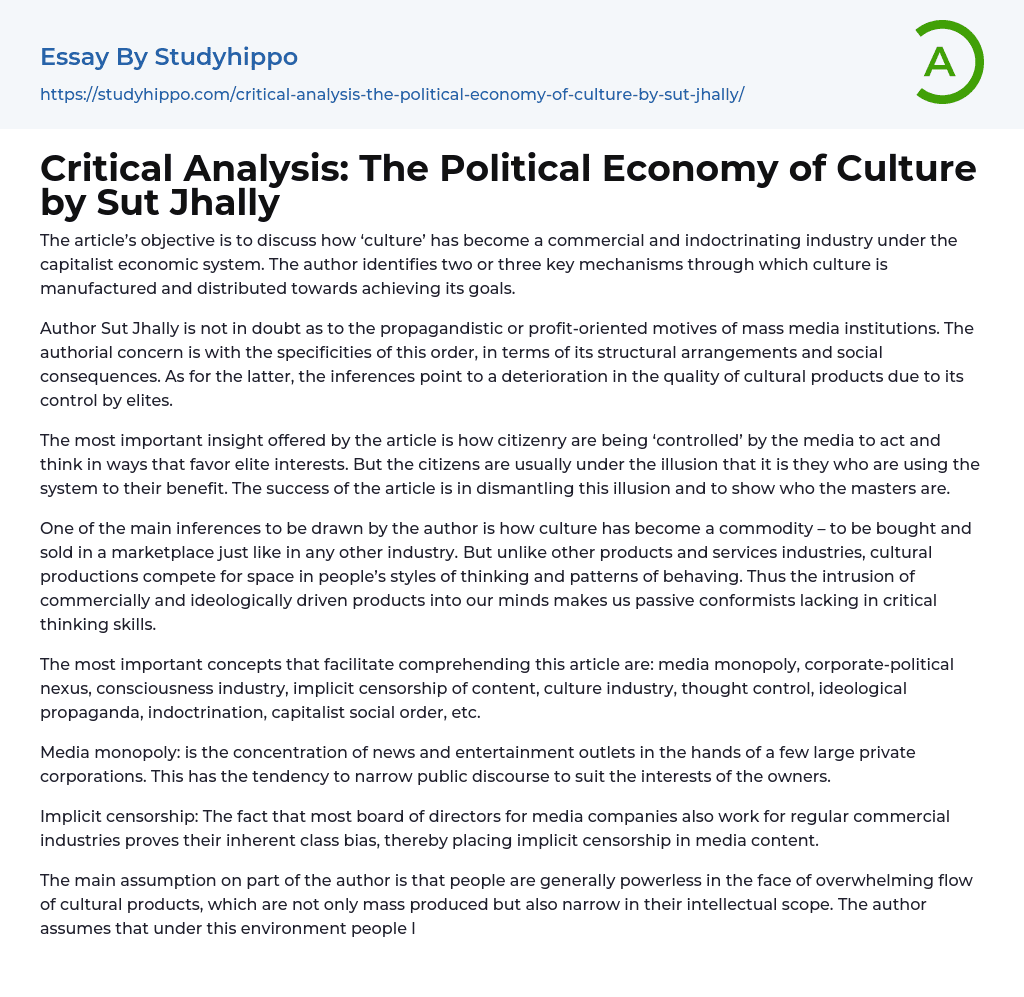

Critical Analysis: The Political Economy of Culture by Sut Jhally Essay Example
The article’s objective is to discuss how ‘culture’ has become a commercial and indoctrinating industry under the capitalist economic system. The author identifies two or three key mechanisms through which culture is manufactured and distributed towards achieving its goals.
Author Sut Jhally is not in doubt as to the propagandistic or profit-oriented motives of mass media institutions. The authorial concern is with the specificities of this order, in terms of its structural arrangements and social consequences. As for the latter, the inferences point to a deterioration in the quality of cultural products due to its control by elites.
The most important insight offered by the article is how citizenry are being ‘controlled’ by the media to act and think in ways that favor elite interests. But the citizens are usually under the illusion that it is they who are u
...sing the system to their benefit. The success of the article is in dismantling this illusion and to show who the masters are.
One of the main inferences to be drawn by the author is how culture has become a commodity – to be bought and sold in a marketplace just like in any other industry. But unlike other products and services industries, cultural productions compete for space in people’s styles of thinking and patterns of behaving. Thus the intrusion of commercially and ideologically driven products into our minds makes us passive conformists lacking in critical thinking skills.
The most important concepts that facilitate comprehending this article are: media monopoly, corporate-political nexus, consciousness industry, implicit censorship of content, culture industry, thought control, ideological propaganda, indoctrination, capitalist social order, etc.
Media
monopoly: is the concentration of news and entertainment outlets in the hands of a few large private corporations. This has the tendency to narrow public discourse to suit the interests of the owners.
Implicit censorship: The fact that most board of directors for media companies also work for regular commercial industries proves their inherent class bias, thereby placing implicit censorship in media content.
The main assumption on part of the author is that people are generally powerless in the face of overwhelming flow of cultural products, which are not only mass produced but also narrow in their intellectual scope. The author assumes that under this environment people lose their ability to critically assess their lives and the society they live in.
The implications of the dominant culture industry are already evident. In the United States, for example, people are poorly informed on a range of foreign policy issues, thanks to the biased media coverage of American diplomatic and military interventions abroad. Likewise, television programs are devoid of meaningful debates on critical issues facing the country. Instead, reality TV and sports are what attract large viewership, testifying the author’s thesis.
Author Sut Jhally clearly articulates how ‘culture’ is no longer the collective social expression that it originally was. In the modern industrial era, commoditization of cultural products has made it homogeneous and sub-standard. More importantly, culture has become an avenue for profit-making for media corporations. It also serves a propagandistic function in maintaining existing economic and social hierarchies. The author clearly, systematically and logically elucidates different facets to the political economy of culture, including the social and economic structural
arrangements that facilitate its success.
The article’s objective is to discuss how ‘culture’ has become a commercial and indoctrinating industry under the capitalist economic system. The author identifies two or three key mechanisms through which culture is manufactured and distributed towards achieving its goals.
Author Sut Jhally is not in doubt as to the propagandistic or profit-oriented motives of mass media institutions. The authorial concern is with the specificities of this order, in terms of its structural arrangements and social consequences. As for the latter, the inferences point to a deterioration in the quality of cultural products due to its control by elites.
The most important insight offered by the article is how citizenry are being ‘controlled’ by the media to act and think in ways that favor elite interests. But the citizens are usually under the illusion that it is they who are using the system to their benefit. The success of the article is in dismantling this illusion .
- Appeal essays
- Revenge essays
- Corporate Governance essays
- Public Service essays
- Income Tax essays
- Supply essays
- Red Cross essays
- Democracy essays
- State essays
- Liberty essays
- Absolutism essays
- Reform essays
- Republic essays
- John Marshall essays
- Bourgeoisie essays
- Developed Country essays
- Elections essays
- International Relations essays
- Left-Wing Politics essays
- Monarchy essays
- Political Corruption essays
- Political Party essays
- Political Science essays
- Sovereign State essays
- United Nations essays
- World Trade Organization essays
- Contras essays
- Dictatorship essays
- Foreign policy essays
- Monarch essays
- Corruption essays
- Foreign essays
- Democratic Party essays
- European Union essays
- President Of The United States essays
- John Stuart Mill essays
- Terrorism essays
- Military essays
- Social Security essays
- Federalism essays
- Gentrification essays
- Hillary Clinton essays
- Public Transport essays
- Health Insurance essays
- Life Insurance essays
- Emergency Management essays
- Insurance essays
- Aviation essays
- Transportation essays
- Presidential Elections essays



